
27 minute read
Valley Partnership
from AZRE May/June 2021
by AZ Big Media
2021
UNTAPPED POTENTIAL
In an era of extreme growth and drought, Valley utilities take major steps to protect and preserve the desert’s most precious resource
By REBECCA L. RHOADES
Arizona is one of the fastestgrowing states in the nation, gaining about 150,000 new residents annually. Along with the rise in population comes an increase in home, business and entertainment development that draws on local utilities. Despite this, the state uses less water than it did more than 60 years ago, when the population was one-seventh the size. According to the Arizona Department of Water Resources (ADWR), the state used about 7.1 million acre-feet of fresh water in 1957; in 2017, that figure had decreased to 7 million acre-feet. An acre-foot is almost 326,000 gallons, or enough to cover a football field in 1 foot of water.
“When it comes to water management, the policy has always been to have long-term planning,” says Dave Roberts, associate general manager of water resources for Salt River Project (SRP). “We stand on the shoulders of some visionary planners who saw the value of harnessing the Salt River and also making sure that we got our fair share of the Colorado River supply.”
More than half the Valley’s water comes from the Salt and Verde river watersheds, which are managed by SRP. Thirty-six percent of the state’s supply comes from the Colorado River. In April 2021, the ADWR announced that Lake Mead, the biggest reservoir on the Colorado River, stands at just 40% of its full capacity. Currently, the river is operating at a “Tier Zero” status, meaning the state is required to contribute 192,000 acre-feet of

Arizona’s 2.8 million acre-foot annual entitlement. This contribution will come entirely from the 336-mile Central Arizona Project (CAP) canal system. Based on its 24-month study, it’s likely that the U.S. Bureau of Reclamation will elevate the shortage to “Tier 1” in 2022. This would require Arizona to reduce usage by 512,000 acre-feet, again, almost entirely from the CAP system.
As unrelenting drought and rising temperatures threaten the state’s watersheds, Valley water leaders are looking at ways to ensure a continued reserve of this natural resource to support development into the next century.
A HEALTHY SUPPLY
“One of the things that is key for SRP is ensuring that the watersheds that produce our water are healthy,” Roberts says. SRP receives water from the Salt River, which is formed by the confluence of the White and Black rivers in the White Mountains to the east of Phoenix, and the Verde River, which flows from Yavapai County to the north.
“Because the Colorado River watershed gets most of its runoff in the late spring and summer, it’s more susceptible to warming temperatures,” Roberts explains. “Runoff in the Salt and Verde systems occurs much earlier, when the sun angles are lower. That makes us more resilient.”
While below-average snowpack this past winter, combined with drought conditions, has reduced runoff — SRP’s total reservoir system is at 75%, down slightly from 98% one year ago — the company’s main concern is the health of forests along the watersheds and the risk of catastrophic wildfires. “We’ve had lot of fires over the past 30 years, and they’ve gotten increasingly larger. They affect the water quality because our supply runs through those lands,” Roberts says. “Water comes through the burned and scarred areas and picks up all kinds of debris and contaminants, making it difficult to treat and deliver.” Preventative thinning of dense brush and small overcrowded trees reduces the fuel that leads to larger, more devastating fires.
On the Verde River side of the system, the uppermost reservoir, Horseshoe Dam, which is shared by SRP and the City of Phoenix, also has its share of difficulties. “The reservoir has been filling in with sediment over the years,” Roberts notes. As of April 2021, the Verde system is operating at just 32%, with Horseshoe Lake at 5% full and Bartlett Lake at 49%. “SRP is working with the Bureau of Reclamation to assess what options we have to mitigate that impact of sediment because we’ve lost more than a third of the capacity,” he adds. “We hope to make a plan to modify Bartlett Dam, expanding its capacity and creating additional supplies for others here in the Valley, outside of SRP. And then we would turn Horseshoe Dam into a facility that would capture sediment and use it to restore the riparian habitat for endangered species in the area.”
TOP: Epcor’s Luke 303 Regional Water Reclamation Facility was finished in 2020. BOTTOM: Wastewater is recycled at Global Resources’ reclamation facility in the City of Maricopa.
WEST VALLEY EXPANSION
One of the fastest-growing regions in Greater Phoenix is the West Valley along State Route 303. Epcor, a privately owned utility company, provides water and wastewater services to thousands of homes and businesses from northern Peoria along the Agua Fria River to Buckeye, as well as areas around Paradise Valley, Fountain Hills, Rio Verde and Queen Creek.
In 2019, Epcor completed a $33 million expansion of its White Tanks Regional Water Treatment Plant in Surprise, which increased the facility’s output from 20 million gallons per day (MGD) to 33 MGD. The site treats surface water delivered by the CAP canal system. “Surface water is considered a renewable resource, and we have allocations from CAP and the Maricopa Water District, and any of the water that is used by our customers comes back to our wastewater collection and treatment systems. It’s a
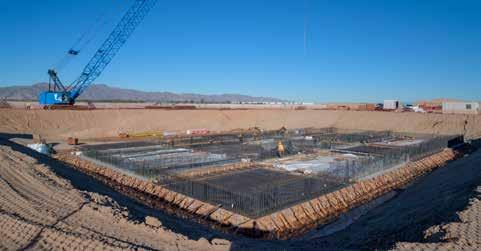
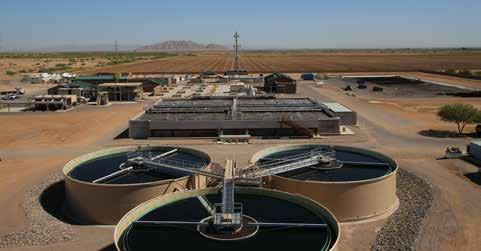
long cycle of sustainability,” says Joe Gysel, president of Epcor USA.
Last year, the company finished construction on Phase 1 of the Luke 303 Regional Water Reclamation Facility in Litchfield Park, which can recharge and reuse up to 8 million gallons of treated effluent daily. Phase 2 of the $95 million project is scheduled for completion in the first quarter of 2022. “It will connect to a new trunk line that we put in last year that runs from north Glendale down to our plant, which is in the shadow of Luke Air Force Base
“That side of the Valley is a very large growth area for us,” Gysel adds. “And all of the wastewater that we collect is recharged 100%. We have large recharge basins, and we treat it to A+ quality standards, and then it all goes back into the aquifer.”
A recent concern in the West Valley is the presence of polyfluoroalkyl substances (PFAS) in the water supply coming from Luke Air Force Base. These chemicals, which were designed to repel oil, water and grease, are found in a firefighting foam that the military began using in the 1970s. A study released by the Air Force in February showed that high levels of PFAS had affected drinking water for about 1,600 homes and businesses, none of which are serviced by Epcor. “PFAS are emerging contaminants that have a lot of people very concerned,” Gysel says. “They pollute the groundwater, and they’re forever chemicals, which means they never dissipate. The main issue is that there’s no minimum contaminant level adjudicated by the Environmental Protection Agency.”
HORSESHOE LAKE: The reservoir that was formed by the Horseshoe Dam on the Verde River. The lake and dam are located upstream and north of Bartlett Lake. The dam is managed by the Salt River Project.
Ron Fleming
AN INTEGRATED APPROACH
High-growth areas, such as San Tan Valley, Buckeye and Pinal County, face the biggest struggles because of low supplies of surface water, which is renewable, and limited groundwater, which is finite.
In most water systems, drinking, waste and recycled water are managed separately. Global Water Resources, a private, investor-owned utility that services communities around Metro Phoenix, offers its Total Waste Management approach, which manages the entire water cycle within the same geographical area. “We look at it from a more holistic standpoint, where it’s best if the water provider is also the wastewater and recycled water provider,” explains Ron Fleming, president and CEO of Global Water Resources. “Instead of building giant wastewater treatment plants outside of town, where you’re limited with what you can do with the effluent once you’ve treated it, we build smaller scale reclamation facilities inside the communities that take the wastewater and convert it into a usable, renewable resource.”
Wastewater is recycled and delivered back for use as nonpotable irrigation for common areas, landscaping and golf courses. Biosolids, the organic masses that are separated from the wastewater, are treated and used for nonconsumption agricultural purposes. If the Bureau of Reclamation initiates Tier 1 shortages, agriculture will be the hardest-hit sector. “What people don’t often realize is that residential and commercial buildings don’t use half the amount of water that agriculture does,” Gysel explains.
The individual customer also plays a role in conservation. Global Water offers an innovative seven-tier rate structure. The less water you use, the less you pay. And if usage is 90% less than the community average, the customer receives a rebate by way of a reduction on their bill. “We’re sending the right price signals for a precious resource and, beyond that, we’re giving people the information they need to be able to act,” Fleming explains. “If they play it right, if they maximize recycled water and recharge any excess to the supply, then they are making meaningful changes.”
For many years, reclaimed water was not regarded as a resource, but in the last 25 to 30 years, policy has been to make use of every drop. Notes Roberts, “Water that has a second or third or fourth life is going to be the key for long-term stability.”
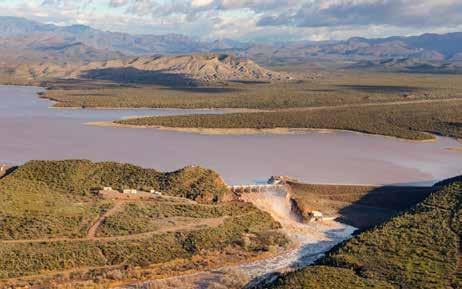
Joe Gysel Dave Roberts
THE HOUSING GAP
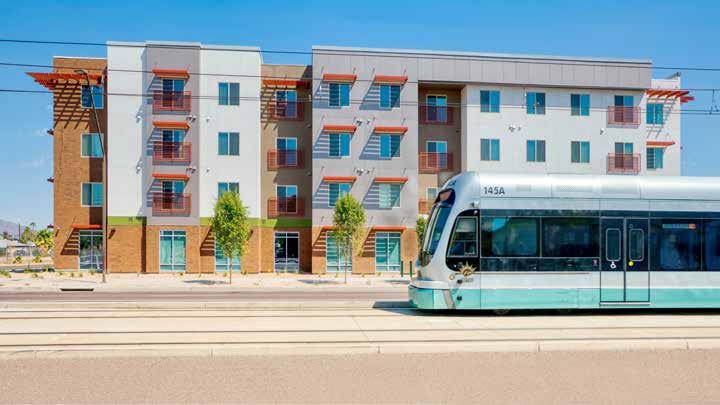
Innovative programs and projects help the Valley’s workforce withstand skyrocketing home costs
By REBECCA L. RHOADES
Recent studies have underscored what Arizona homebuyers and renters have known for some time: The state, and particularly Metro Phoenix, has a shortage of attainable and affordable housing. The recent population explosion, combined with rising construction costs, a surge in house flipping and the public’s desire for top-of-the-line amenities and finishes, a phenomenon known as the “HGTV effect,” has resulted in a dearth of homes with price tags that are within reach for the average worker.
Much has been said recently about the need for homes for families at or below the poverty guideline. A report by the National Low Income Housing Coalition found that Arizona has the country’s fourth-worst affordable housing shortage; Phoenix also ranked fourth among major cities. Low-income housing is defined as “housing that is affordable to households earning 30 percent of the area median income (AMI).” The AMI is the income for the median, or middle, household in a region. It is used by the U.S. Department of Housing and Urban Development to determine eligibility for federal housing programs. The AMI for a single person in Maricopa County is $33,000; for a family of four, it’s about $73,000.
Workforce housing requires earnings of 60 percent to 120 percent of the AMI. Sally Schwenn, market president for Gorman & Company, says, “Workforce is your nurses, your firemen, your teachers, your service providers.” These are typically people who make too much money to receive government-subsidized housing yet are often priced out of the current market. According to HUD’s Fair Market Rents report, the statewide average cost of a two-bedroom apartment is $1,097; prices are much higher in Maricopa County. To afford this level of rent (30 percent or less of gross income), as well as utilities, a household would need to earn $43,892 annually, or an hourly wage of $21.10. Arizona’s minimum wage is $12 per hour.
Unfortunately, wages have not kept pace with rising rents and home prices. According to Zillow’s latest market report, released in March, metro Phoenix recorded the highest annual growth in home values in 2020 — 17.1 percent over the last year, with the average price being $248,000. “For the workforce, trying to rent a two-bedroom apartment for a few thousand dollars a month or purchase a $300,000 house is a luxury that’s hard to attain,” Schwenn notes.
In July 2020, Phoenix Mayor Kate Gallego announced a plan to address the city’s housing shortage. Known as the Housing Phoenix Plan, its goal is to develop 50,000 affordable, workforce and market-rate housing units by 2030 by prioritizing opportunities for new housing areas, amending current zoning ordinances and redeveloping city-owned land, among other initiatives.
In Tempe, where demand outstrips inventory and luxury multifamily developments are popping up on just about every corner, Mayor Corey
THE RIVER AT EASTLINE VILLAGE: Completed in 2019, this Tempe community offers 56 affordable housing units.
LIFE IN EVERY DIRECTION
ESTRELLA.COM


There’s something to satisfy every lifestyle in Estrella, the community where modern living meets the natural thrills of the High Sonoran Desert. Explore today from the comfort of your home by taking a virtual tour of our model homes and amazing amenities like the StarSplash WaterPark, Presidio Residents Club, Star Tower, and more. Your virtual Estrella experience starts here: Estrella.com/Virtual


New homes from the high $200,000s to over $400,000s
Beazer Homes • D.R. Horton • Gehan Homes • Rosewood Homes • William Ryan Homes
CantaMia® by Taylor Morrison 55+
Coming Soon: Landsea Homes • Terrata Homes • Toll Brothers Custom Home Sites from the $70,000s For more information or questions you can call or live chat with us daily between 10 am - 5 pm. Exit I-10, south on Estrella Parkway, then turn right on Hillside Drive 623.386.1000
@EstrellaAZLife
Newland is the largest private developer of planned residential and urban mixed-use communities in the United States. We believe it is our responsibility to create enduring, healthier communities for people to live life in ways that matter most to them. newlandco.com
NNP III – EMR 3, LLC and NNP III-EMR 4, LLC (“Fee Owner”) is the owner and developer of Estrella Community (“Community”). Fee Owner has retained Newland Real Estate Group, LLC (“Newland”) solely as the property manager for the Community. Homebuilders, unaffiliated with Fee Owner, Newland, or their affiliates (together, the “Released Parties”) are building homes at the Community. The Released Parties are not co-developing, co-building, guarantors of, or otherwise responsible for, nor shall they incur any liability as a result of, any of the obligations or representations made to buyers by any Builder or other third-party. Fee Owner’s responsibility with respect to the Community is limited to the development of certain infrastructure improvements (e.g., roads, sewer, etc.) and such obligations run solely to persons buying real property directly from Fee Owner. Buyers of homes and Builders waive, to the fullest extent allowed under the law, any and all rights, claims, causes of action and other rights whatsoever against the Released Parties arising out of their purchase of a home or services, respectively, in the Community from Builders or any other third-party. Fee Owner may seek to qualify real property located in the Community for offering and sale in those states where prior qualification is required before such interests in out-of-state real property may be offered for sale or lease to its residents. Fee Owner has notified Builders of such qualification requirements and it is the obligation of such Builders to comply with any and all federal or state land sales laws as mandated by their contractual relationships with Fee Owner and to distribute all required disclosures, including but not limited to, disclaimers and reports to prospective purchasers prior to or at execution of a contract of sale for real estate. Any prices, sketches, renderings, and specifications contained herein are proposed only and subject, without notice, to change or withdrawal at any time. All, or a portion, of CantaMia in Estrella is designed for Housing for Older Persons pursuant to the Housing for Older Persons Act. The community has established policies and procedures which demonstrate intent to provide housing for persons 55 years of age or older. EQUAL HOUSING OPPORTUNITY.
Woods has prioritized the development of attainable housing. In January, the Tempe City Council approved the Home Town for All initiative, which aims to create more affordable and workforce housing opportunities through developing, acquiring and rehabilitating city properties.
For every project built in Tempe, 50 percent of certain permitting fees paid to the city will be directed to the Tempe Coalition for Affordable Housing. The money will be used to buy and renovate properties, or purchase land and request offers from developers to build affordable and workplace units. “We’re also asking for additional voluntary contributions,” Woods notes. “If you’re building a market-rate complex, that amount would be 20 percent of the total permit and developing fees, while a commercial or office structure would be 10 percent. Between the fees and the voluntary contributions, we will raise between $2 million and $4 million per year.” To kick off expansion plans, the council in April provided a $1.2 million transfer from the municipal general fund to the program.
Woods points to best practices used by other states to counter rising home prices, including tax increment financing, whereby cities divert future property tax revenue increases toward economic development; rent control; and inclusionary zoning. All are prohibited in Arizona. “Another challenge is that we have a lot of older multifamily apartments in our community,” he says. “Some people will say, ‘Well, that’s attainable housing right there.’ But these places don’t have the comforts and amenities that are suitable for 2021. We need to make sure that we have housing in this day and age that people want to live in.”
Real estate developer and manager JES Holdings often collaborates with cities to address workforce housing needs. “Municipalities are often hyperfocused on workforce development, but they have to have the housing available or these large companies aren’t going to relocate,” explains Will Markel, executive vice president for JES Holdings.
“You need a smorgasbord of housing,” he continues. “If a city has private developers who focus only on high-end living, it’s not addressing an important societal issue. It needs to incentivize the development community to build homes of the same quality but target them to people in a different economic stratosphere.”
Markel points to a project his company developed in South Phoenix, in the shadow of South Mountain Park and Preserve. South Summit Estates is a 98-unit 55+ housing development with rents ranging from $450 for a 600-square-foot studio to $800 for a 900-square-foot two-bedroom unit. “Many retirees can’t afford luxury senior living, but they want a Class A-type apartment,” Markel says. The complex was fully rented in three months, and the waiting list is more than 100 people long.
Looking forward, Arizona’s growth shows no signs of slowing down “We realized that we’re going to need more than 11,000 more units of housing in Tempe alone by the year 2040, just to keep pace with demand,” Woods says. Getting municipalities and developers to invest in this drastic need for housing comes down to getting these projects financed. Adds Wood, “Every family should have the opportunity to achieve the American dream.”
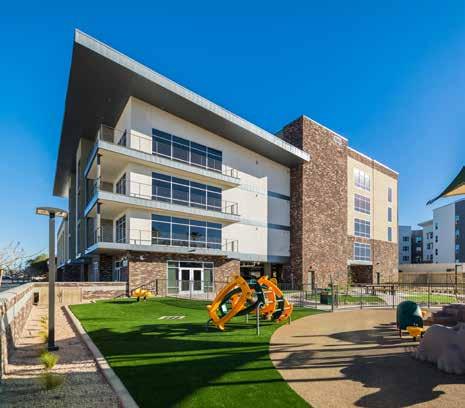
Will Markel Sally Schwenn Corey Woods
VALOR ON EIGHTH: This 50-unit development serves veterans and their families.
GIFT CLAUSE CLARITY
Will the Supreme Court decision on indirect benefits hinder economic development?

By REBECCA L. RHOADES
It’s a question that cities have struggled with for years: Do the economic incentives that are offered to draw in companies benefit the entire community? According to a recent court ruling, that answer may be “no.” It’s a decision that could have sweeping implications on future development.
On February 8, the Arizona Supreme Court unanimously ruled in Schires v. Carlat that the City of Peoria violated the State Constitution’s Gift Clause when it promised to pay a private university and its property owner in exchange for opening a campus in the city.
The Gift Clause, adopted in 1912, requires public expenditures to satisfy a two-pronged test: first, whether the challenged expenditure serves a public purpose and, second, whether the value received by the public exceeds the consideration. A contract law term, “consideration” refers to something of value given to someone in return for goods, services or some other promise. “It just means value,” says attorney Cameron Artigue, partner at Gammage & Burnham. “Is there enough value coming out of this contract?”
Adds Grady Gammage Jr, founder of Gammage & Burnham, “The intent of the Gift Clause was to stop public corruption. You can’t give away public property for free, and you can’t take public money and loan it to a friend of yours.”
The five-years-long legal fight hinged on Peoria granting $2.6 million in incentives to Indiana-based Huntington University and the school’s landlord to establish a satellite campus in the city. Of that amount, $1.89 million would be paid over a three-year period as the university hit performance thresholds. The remainder, slightly more than $700,000, would go to the landlord for tenant improvements. A comprehensive analysis of the impacts of the deal, commissioned by the city, determined that the university would provide jobs for area residents as well as quality educational opportunities and would enhance the vitality of its surroundings.
The court reconfirmed the long agreed body of law that economic development is a public purpose — meeting the requirements of the first test prong. However, in Schires, it ruled that the payments to the university and the landlord did not meet the adequacy of consideration prong because the benefits provided by the university were “indirect” and not “bargained for” as part of the promised performance, and therefore not of objective value when it came to determining adequacy of consideration. “Indirect benefits” are results that cannot be immediately measured, such as anticipated tax revenue and employment opportunities, and are not an enforceable promise to the public by the other party. On the other hand, “direct benefits” include goods and services provided by the business to the city, as well as the improvement of public property.
“Indirect benefits are the entire reason cities do these deals — to increase their tax base, to make their city more vital, to incentivize development in a particular part of town,” Gammage notes. “They are investments, not gifts.”
The seeds for this litigation date back decades to 1984’s Wistuber v. Paradise Valley Unified School District — in which consideration for a public payment was certain duties performed by a teacher’s association president in lieu of teaching — that set forth the two-prong test for Gift Clause compliance. “Wistuber was the seminal case. It was very deferential to city councils and was the law of the state until 2010,” says attorney Jay Kramer, partner at Fennemore Craig.
That all changed in 2010, with the decision in the Turken v. Gordon case,
Cameron Artigue Tom Belsche Grady Gammage Jay Kramer
also known as the “CityNorth” case, in which the Supreme Court took a more narrow position as to what consideration is appropriate for Gift Clause purposes. The case involved the development of a 144-acre mixed-use complex in Desert Ridge. To entice CityNorth to build, the City of Phoenix entered into an agreement whereby the developer would provide more than 3,000 parking spaces, including 200 park-and-ride spaces, that would be free to the public for 45 years. In return, it would pay CityNorth up to $97.4 million in sales tax over a period of 11 years.
Fennemore Craig and Gammage & Burnham, among others, represented the city and developer in the case. While the Supreme Court found in favor of their clients, it held that, for the purpose of the Gift Clause, an amount paid to a developer cannot be grossly disproportionate to the consideration received by the city. “We won that case, and the developer was entitled to receive the tax incentives as agreed, but we lost the war, because Turken was the first time that the court held that indirect benefits would no longer be ‘consideration,’” Kramer says.
Schires takes that a step further by holding that economic impacts, such as construction sales tax, retail sales tax, and other municipal tax revenue arising directly from the planned project, are anticipated indirect benefits that are valueless under the consideration prong. The court also held that it would no longer defer to public officials on the actual value of the transaction. “It has always been part of Arizona law that courts will give legislative bodies the benefit of the doubt,” Artigue says. “In Schires, the Supreme Court said no more abuse of discretion, no more deference. Judges should now determine, in the first instance, whether adequate consideration exists.”
So what happens next?
Tom Belsche, executive director of the Arizona League of Cities and Towns, notes, “Economic development happens in all cities and towns, and it plays a huge role in attracting new businesses. It’s extremely important that we get some clarity on this area, or we risk falling behind to other states. We’re in a very competitive market. We not only compete with our fellow states in the Intermountain Region, but we also compete globally for businesses. In order for Arizona’s economy to remain strong, we have to find ways to do this that meets this new requirement.”
Because the ruling is so new, cities and their legal teams are still struggling to understand all of the implications, but incentive agreements will always remain a viable economic development tool to attract and retain businesses. The Gift Clause is part of the Constitution, and the legislature would need to refer any change to be voted on by the public, something Gammage does not believe will happen.
In addition, it is important to note that the Schires case does not involve GPLETs, or government property lease excise taxes. Under the GPLET program, property owners deed over their land to the city for a period of no more than 25 years, during which time they pay no property tax. Schires is about general revenue or sales tax-based incentives.
“In the future, cities are going to have to be very explicit about the types of benefits they receive,” Gammage explains. “For example, if they want to give $2 million to a college, they’re going to have to get $2 million worth of tuition credits for their residents. The trickier question is what happens when you’re dealing with a large factory? What are your benefits when jobs and tax revenue don’t count?”
Artigue recalls a 20-year-old case in which the Supreme Court held that declining to collect tax revenue cannot violate the Gift Clause because the money is flowing in the opposite direction. “If you never collect the revenue, you steer clear of the gift,” he says. “Whereas collecting the money and then paying it out is a problem.” Artigue and his colleagues have been advising clients to guarantee that indirect benefits are made direct by incorporating them into the terms and conditions of the contract. “Don’t just say, ‘Hey, look at all the jobs that are being created. Isn’t that great?’ It should be brought into the contract as a performance threshold so that an incentive is earned by the private party hitting that criterion.”
Kramer says that he has been talking to his clients about agreeing, when they contract with a municipality, to guarantee over a period of time a certain amount of tax revenue to the municipality even though that is an anathema to developers. “Under Turken, Schires and other Supreme Court cases, there is an argument that if the developer makes an enforceable promise to provide certain economic impacts, those impacts go from anticipated indirect benefits that are valueless to direct benefits that constitute consideration for Gift Clause purposes,” he explains.
Artigue offers this advice: “Schires is the second real estate-oriented agreement to be litigated in the last 10 years, so it’s a miniscule proportion of deals that wind up in court. There is, to use a topical phrase, a sort of herd immunity — a safety in the pack. If you can avoid making yourself an attractive target, you should be safe.”
Overcoming crisis
Valley Partnership’s rapid pandemic response helped champion Phoenix’s economic resiliency
By REBECCA L. RHOADES
The first case of COVID-19 was confirmed in Arizona in late January 2020, but it wasn’t until Gov. Doug Ducey issued a stay-at-home order two months later that most businesses closed down and employees began working remotely.
“We all thought, ‘Hey, let’s go home for two weeks and then come back to work,’” recalls Tim Brislin, vice president of Harvard Investments and 2020 Chair of the Valley Partnership Board of Directors. The order was only supposed to last through the end of April but, one year later, a number of businesses still are not up and running 100%. “Everyone had completely different plans for the year than what came to be,” Brislin adds.
While some sectors, particularly the restaurant, hospitality and smallbusiness industries, saw devastating losses, with many operations closing permanently and unemployment rates spiking more than 50% over the previous year, development in the Greater Phoenix region continued to thrive, thanks in part to the efforts of Valley Partnership. But there were still plenty of challenges to face.
“Everyone was living not just day by day but literally moment by moment,” says Cheryl Lombard, president and CEO of Valley Partnership.
MAKING ADJUSTMENTS
Non-essential businesses that were forced to close their doors during the shutdown voiced concerns about their economic future. “If you’re not that well-capitalized, ceasing operations for two weeks can be a death knell,” Brislin notes. On the construction side, keeping the work and money flowing was vital. “There were big concerns about the ability to do transactions. What happens if title companies shut down, if you can’t record documents or you can’t send wires? Most disaster plans spell out backups in case a city’s banking system closes, but what do you do when the entire country isn’t open?”
To address these and other concerns and brainstorm solutions, the team at Valley Partnership held weekly Monday morning calls with executives of its developers. “We represent all facets of development: industrial, retail, office, commercial, master plan. People wanted to know what the governor’s emergency order meant to them, their properties and their tenants,” Lombard says. The issues raised were then addressed in calls to Ducey, Phoenix Mayor Kate Gallego and federal legislators.
As a result, construction and real estate were deemed essential services, and inspections could progress virtually, allowing projects to continue moving forward. “Our No. 1 concern was having consistency,” Lombard explains. “Hypothetically, one city could do something completely different from another city or the state.” Valley Partnership worked closely with the governor’s office to ensure statewide uniformity when it came to defining who and what are essential.
Landlords were also confronted with commercial tenants who were unable to pay rent because they were closed or operating at limited capacity. Companies that were financially hurting were seeking programs that would keep retail and residential tenants in place. While the federal housing moratorium was recently extended until June 30, 2021, the commercial freeze was lifted in May 2020. “Our members were generally able to structure deals that tacked what couldn’t be paid at that time onto the end of their leases. On the commercial side, it really saved a lot of businesses from closing,” Lombard says.
Cheryl Lombard Tim Brislin REACHING OUT
On the federal level, Valley Partnership reached out to Sen. Martha McSally and Rep. Andy Biggs to initiate discussions about restructuring loan payments and extending deadlines on facets such as 1031 exchanges and opportunity zones. “Those have very tight deadlines that obviously couldn’t be met,” Lombard points out. “We specifically worked with Sen. McSally and the Treasury Department to extend the limits, because otherwise a bunch of deals would have blown up.”
Even in the pandemic’s earliest days, members of Valley Partnership never had to worry about a lack of information. The popular monthly Friday Morning Breakfasts pivoted from paid in-person events to free Zoom meetings that frequently include presentations by city and state officials. These virtual gatherings are scheduled to continue through the end of 2021. Weekly e-blasts also provide updates about any topic that might affect businesses on a federal, state or city level. The quick implementation of all of these actions enabled development in the Valley to proceed with limited setbacks, even as much of the country came to a standstill.
“It was really quite fascinating to see how we have adapted over a year,” Lombard says. “This is something nobody’s ever faced before. We didn’t know what was going to happen or how this virus was going to affect people. Everything was so uncertain.”










